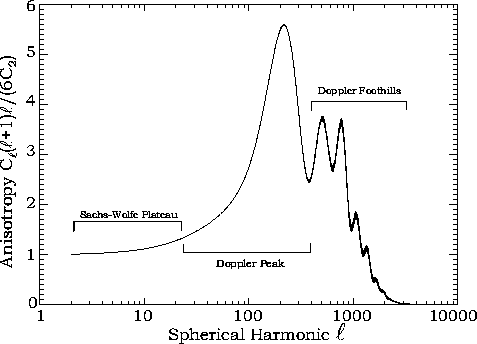CMB Power spectrum

CMB Power Spectrum
The idea of an angular power spectrum might seem a little odd when one normally meets the word 'spectrum' refering to a frequency range (ie audio spectrum or the light spectrum, which brings images of rainbows to mind). An angular spectrum just refers to the amplitude of regular variations of some quantity (temparture or intensity) with angle. For example the picture produced by a television not tuned-in, shows a flat 'white-noise' power spectrum which is similar to that expected from the CMB.
Emerging out of this 2D 'white-noise' spectrum are expected regions of enhanced signal at about 1º and on smaller scales, which is usually referred to as the first, second and so-on "Acoustic'' peaks. In this way the spectrum can be divided, rather arbitrarily, into large ( >0.5º ) and small ( <0.5º ) angular scales on either side corresponding to the "Sachs-Wolfe plateau'' and the "Acoustic foot-hills'' respectively, and in is in this latter region the VSA is working. An example power spectrum expanded in spherical harmonics showing these features is shown in the figure for a standard Cold Dark Matter (CDM) model.
Although called the "Doppler'' peak the Doppler effect is only one of the mechanisms which contribute to it. The others are intrinsic temperature variations and the early integrated Sachs-Wolfe effect. The reason for the peaks is that perturbations starts to grow in density with the over-dense zones collapsing and the under-dense expanding until the tightly coupled photons can resist gravity via radiation pressure and reverse the direction of the oscillation. Each peak in the angular power spectrum corresponds to oscillationswith just the right wavelength that they hit these extrema (turning points) at the time of re-combination, when the Universe became transparent.
We see these perturbations distributed over the sky now because this re-combination approximately 400,000 years after the 'Big-Bang' allows us to see a spherical slice through this hot early universe, now stretched and red-shifted to a distance of 15 Giga-light-years (or so).
The exact mixture of material in the early Universe (baryonic, neutrinos, cold dark matter), cosmological parameters (H0, vacuum energy) and initial perturbation spectrum control the position and amplitude of these peaks and troughs, so the measurement of the angular power spectrum is a vital part of cosmology.


